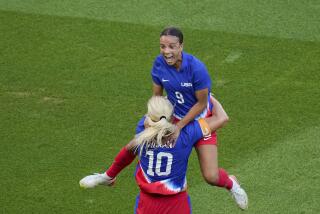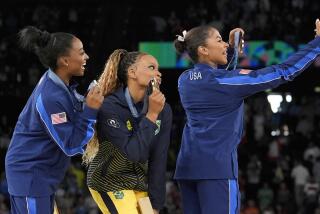<i> All</i> the Granatos Are Hockey Players : Olympic Festival: Cammi, who grew up playing with her three brothers, is a standout for the U.S. women’s team.
SAN ANTONIO — When siblings become elite athletes, it is probably not coincidence. It’s because they grew up pushing each other.
Inevitably, though, life presents different challenges for each on the way up.
Consider the Granatos--Tony, Don, Rob and Cammi.
Hockey has been a way of life for them. Tony, who plays for the Kings, and Don, who helped Wisconsin to an NCAA title in 1990, became stars. Rob plays for Wisconsin.
But for Cammi, who grew up as the only girl on a series of boys’ hockey teams, there came a point when she had to quit the sport. The boys in her age group had grown much stronger, and the threat of serious injury was too great.
There were no girls’ teams where Cammi lived, in Downers Grove, Ill., so her hockey stick fell into disuse.
That was eight years ago, two years before Granato discovered women’s hockey. Since then, she has become one of the best players in the women’s game.
This week, Granato is leading the United States national women’s hockey team in two exhibitions against the Canadian women at the U.S. Olympic Festival.
Granato, a 5-foot-7, 140-pound forward, had three assists Friday to lead the United States to a 6-3 victory over Canada. The teams play again today in the Alamodome.
It is the first time women’s hockey has been included in the festival. It will be a medal sport at the 1998 Olympics at Nagano, Japan.
When Granato was young, she never imagined that she would have a chance to play in the Olympics. She never imagined playing beyond the midget league in her town.
After sitting out two years, Granato discovered some colleges on the East Coast that offered scholarships in women’s hockey.
“It was like a dream come true for me, because I could finally go some place and not just be the only girl,” Granato said.
Granato decided to attend Providence, and Lady Friar Coach John Marchetti was ecstatic, though he had never even seen her play.
“Just coming from that type of a family, you know ,” Marchetti said.
Granato, who completed her senior season at Providence this spring, led the Lady Friars to Eastern College Athletic Conference championships in 1992 and 1993. She was named the conference’s player of the year three consecutive seasons.
Granato attributes her success to a childhood spent playing hockey with her brothers.
Until she was 7, she lived with her family in Broadview, Ill., across the street from a park that was flooded in the winter for skating.
The Granato kids spent all day playing hockey in the park. They stomped indoors for dinner, still wearing skates, then headed back out for more hockey.
Cammi was never far behind.
“I looked up to all of (my brothers) because they were older, and I wanted to do whatever they did,” Granato said. “I got kicked around a little bit, I think, but I just kept coming back for more and, finally, they accepted it.”
Cammi’s brothers had to accept it because they needed players for practice. Also, she was good.
“It was never a problem with her being able to keep up or fit in the game,” said Tony, a 1988 Olympian. “I think we were one another’s best fans.”
But Karen Kay, coach of the U.S. women’s team, said that not everyone is ready to accept women’s hockey.
“Even today, with as much as things have changed . . . you’re still going to be challenged on everything you say,” Kay said.
Female hockey players came into the public eye this winter when Canadian goalie Manon Rheaume was signed by the Tampa Bay Lightning. She played in an NHL exhibition, the first woman to do so, and also played for the club’s minor league affiliate at Atlanta.
Players and coaches at the festival agreed that, although Rheaume brought attention to women’s hockey, she did little to advance their sport.
“To think that we are all working toward getting the first women on the ice in the NHL is ludicrous,” said Glynnis Peters, the general manager of the Canadian women’s team.
The main difference between the men’s and women’s versions of hockey is that there is no checking in the women’s game, although that does not mean it is not physical.
There have been two world championships in women’s hockey, in 1990 and 1992. Granato led the United States to the silver medal both times, and Canada has won two golds. The United States will play host to the next world championships, in 1994 at Lake Placid, N.Y.
An estimated 6,000 women play hockey in the United States, 20,000 in Canada. Although its new Olympic status will help, the sport clearly has a long way to go before it becomes popular. Fewer than 1,000 attended Friday’s U.S.-Canada exhibition.
But superstar status is not what it’s all about for Cammi Granato, who, like Tony, wears No. 21.
“I just wanted to play,” she said.
More to Read
Go beyond the scoreboard
Get the latest on L.A.'s teams in the daily Sports Report newsletter.
You may occasionally receive promotional content from the Los Angeles Times.






